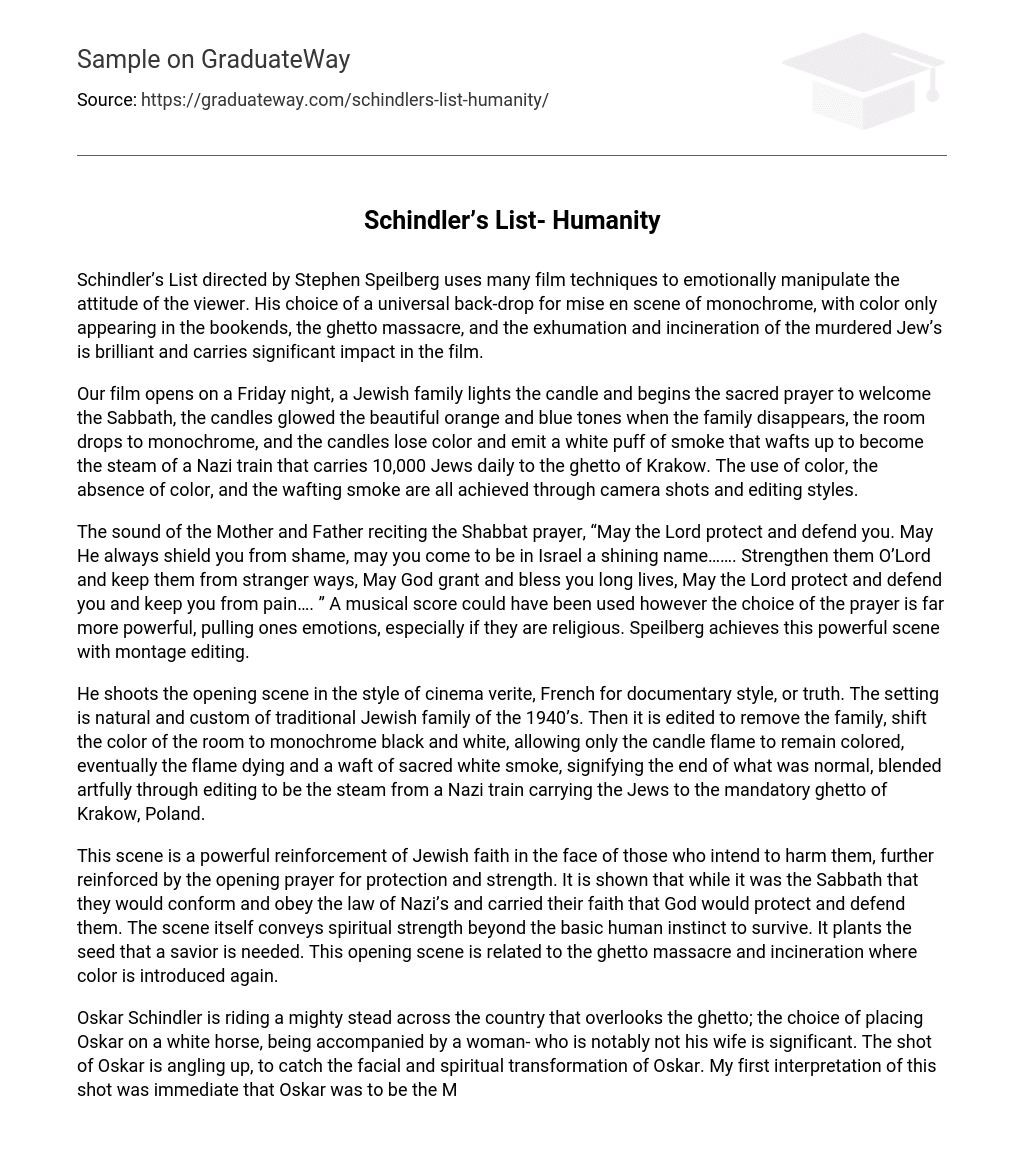Stephen Speilberg’s Schindler’s List utilizes various film techniques to emotionally sway the viewer’s attitude. The decision to employ a monochrome mise en scene, with color reserved for specific moments such as the bookends, the ghetto massacre, and the exhumation and incineration of the murdered Jews, is a remarkable choice that greatly impacts the film.
Our film starts on a Friday night as a Jewish family gathers to light the candle and commence the sacred Sabbath prayer. The candles illuminate with gorgeous hues of orange and blue, but as the family vanishes, the room transforms into monochrome. Simultaneously, the candles fade in color and release a white puff of smoke which then transforms into the steam emanating from a Nazi train transporting 10,000 Jews daily to Krakow’s ghetto. The manipulation of color, its absence, and the drifting smoke are all skillfully achieved through camera shots and editing techniques.
The sound of the Mother and Father reciting the Shabbat prayer, “May the Lord protect and defend you. May He always shield you from shame, may you come to be in Israel a shining name……. Strengthen them O’Lord and keep them from stranger ways, May God grant and bless you long lives, May the Lord protect and defend you and keep you from pain…. ” is more powerful than using a musical score. It pulls one’s emotions, especially if they are religious. Speilberg achieves this powerful scene with montage editing.
In the opening scene of the film, the director uses the style of cinema verite, which is a French term for a documentary-style that aims to portray truth. The scene shows a natural and traditional Jewish family in the 1940s. However, during the editing process, the family is removed and the room’s color is changed to black and white, except for the candle flame which remains in color. Eventually, the flame flickers and dies out, accompanied by a waft of sacred white smoke. This symbolic scene represents the end of normal life. Through clever editing techniques, the sacred white smoke seamlessly transforms into the steam from a Nazi train carrying Jews to the mandatory ghetto in Krakow, Poland.
The opening scene of the video serves as a strong display of the Jewish people’s unwavering faith in the midst of threats against them. This belief is further emphasized through the initial prayer, which asks for divine protection and endurance. Despite the fact that it was the Sabbath, the Jews choose to abide by the Nazis’ laws while trusting that God would shield and support them. Beyond mere survival, this scene conveys a profound spiritual resilience. It hints at the notion that a savior is necessary and foreshadows the upcoming events of the ghetto massacre and incineration, during which color makes a reappearance.
Oskar Schindler is seen on a powerful horse, traversing the countryside and looking over the ghetto. The decision to depict Oskar on a white horse is important, as he is accompanied by a woman who is not his wife. The camera angle, pointing upwards, captures Oskar’s facial expression and his spiritual evolution. Initially, I interpreted this scene as suggesting that Oskar would become the savior of the Jewish people. However, upon further examination, I believe that this scene, along with the subsequent panning shots, symbolizes Oskar’s transformation from a womanizing playboy and Nazi supporter to a protector of the Jews under his care.
The sound of gunfire is exchanged with a chilling violin solo. A young girl, dressed in a red coat, nervously wanders through the chaos of Nazi aggression. People are being killed all around her, and her movements betray both fear and urgency. Oskar, upon witnessing this scene, shows through his body language on the horse that he wants to rescue her. The camera focuses on Oskar’s companion, who also recognizes the gravity of the situation. It is at this moment that Oskar realizes what he must do. Oskar’s transformation is now complete. Once again, the red coat reappears, as the girl is thrown into a burning pile of corpses.
Oskar previously saw the ash on his car as annoying, but the girl in the red coat gave him redemption. The movie evokes strong emotions throughout, with Schindler’s Jews honoring him by placing stones on his grave. While the film itself is portrayed in shades of gray, it conveys a clear message about the importance of protecting humanity – depicted in stark black and white. There is no middle ground; gray represents survival, black represents death, and white represents redemption and abundance. We can’t change the past, but we can shape the future to prevent such atrocities from happening again in Krakow, Auschwitz, and Birkenau (Speilberg). I believe this film offers understanding of religious culture and persecution. As a Catholic, I wondered why Pope Pius XXI didn’t speak out against these killings. In his 26-page Christmas speech that lasted for 45 minutes, he vaguely referred to righteous ethics and civil human rights.
During a critical time, Pope Pius XXI and his Bishops and administration opted for silence. However, Benedict has now taken a more politically correct stance by lifting excommunications against those who served under Pius’s leadership, likely in response to public outrage. The potential of the Catholic Church to have played a significant role in saving Jews is noteworthy. Even the act of saving just one life could have had a profound impact on the world as a whole. These circumstances make me question whether a religion that delays the voice of humanity aligns with my beliefs. It is worth mentioning that the Church not only attempted to suppress Galileo but also persecuted him; yet now it desires to honor him and commemorate his discoveries. Progressing at such a sluggish pace for the sake of humanity is something we cannot afford.





